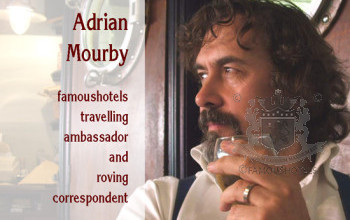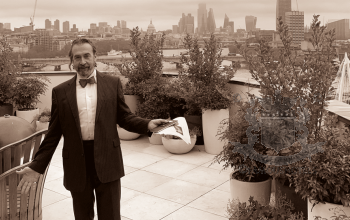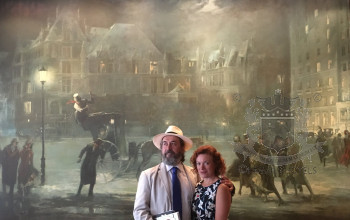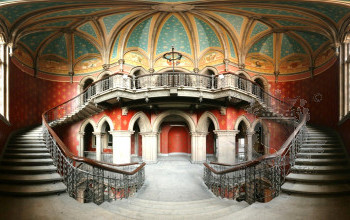The Dorchester - revisited
( words)
The Dorchester is quirky, eclectic and very British. It sits like a section of some 1930s luxury liner plonked down on Park Lane. No two bedrooms the same. Scots warriors, clad in tartan, are stencilled on to the walls of the Grill. The Orchid Room was decorated by one of the Queen Mother’s designers to look like a giant piece of blue Wedgwood. No, despite the Lamborginis and Minis with Arabic number plates out front, nearly half the hotel’s custom is from the UK, people who arrive by tube or in their mud-spattered Range Rovers. Prince Philip spent the night before his wedding here. You cannot get more British than that.
My host was Rosanna Crawley who heads the PR department. Together we poke our heads into the laundry room where guests’ shirts are washed, pressed and then boxed up in cardboard and cellophane so slickly you could set up a stall and sell them. We also call in and chat to three of the hotel’s flower ladies, Wendy, Mandy and Izumi, who work as handmaidens to the head florist Belinda Bowles. They seem very happy in their small workshop on the second floor but then if you like flowers and get to spend £1,500 on a quiet day (up to £30,000 when there are big functions) there’s a lot of job satisfaction to be had at The Dorchester.
In the kitchens – the biggest in Europe – we miss Claude Lamarche, the pastry chef who isn’t in till later, but I do see the special, extra-long Dorchester loaves arriving ready sliced. It is from these Bernie the sandwich king creates over 2,000 rounds a day.
As we emerge our way is briefly barred by the powerful figure of Henry Brosi, the Dorchester’s Executive Chef from Heilbronn-Sontheim in Germany. Henry is one of those reassuringly large chefs who clearly enjoys food. At the moment he oversees more than 100 fellow chefs producing food in six different kitchens. Henry tells me that on 20 September he will be demonstrating his new project, the refurbished Krug Room, a 12-person dining chamber actually inside the kitchens. It’s hidden behind electrochromic glass which means that at the touch of a button Henry can make the glass wall opaque for privacy but then clear when he thinks you will want to watch the food being prepared. Dishes in this room will be designed to complement the hotel’s collection of wines and Krug Champagne. “We can arrange pretty much every vintage,” Rosanna tells me. Of course they can.
Now it’s time to see the public areas. I can tell that my hostess is enjoying this tour as much as I am. Rosanna is young but she feels in her line of work there’s nowhere to go after The Dorchester. “Nothing’s going to better this,” she tells me as we take a lift up to the eighth floor. Together we slip through an unremarkable panelled door to a flight of steep carpeted stairs. At the top of these is the Harlequin Suite, revamped by top New York designer Alexandra Champalimaud. This is the most expensive of the three suites added in the 1960s. Elizabeth Taylor always stayed here and the hotel installed a pink marble bathroom just for her. It’s been preserved exactly as it was on the day that she received and signed Hollywood’s first multi-million dollar contract for Cleopatra. When I get a glimpse it’s more functional, less well finished than you’d expect. We forget how close to post-war austerity the early 60s were.
The Harlequin Suite costs a cool £7,450 per night, and that’s without VAT. It’s difficult to imagine the kind of income someone needs to have in order to blow that amount of money on one night in a hotel, although I know that Nicole Kidman and Arnold Schwarzenegger may well have done so. No expense has been spared on the décor - American walnut floors, gold silk curtains from Thailand, leather chaises and walls upholstered in ivory silk - but I can’t help feeling for that amount of money I’d want Arnie and Nicole to be sharing it with me, and for them to tell me afterwards that I was there best friend ever.
As Rosanna opens the door to the suite’s kitchen, we come face to face with Miguel Rodriguez-Silva, one of three butlers assigned to these suites under the guidance of Paul Pritchard, head butler and late of the royal household. Miguel is all smiles as if he is delighted rather than surprised to see us. He has just prepared coffee for the new arrivals who will be up shortly, but there’s absolutely no sense of rush. He is happy for us to wander out on to the terrace, which has a superb view of Hyde Park. Apparently Hitchcock, looking at this view, declared the Dorchester a perfect place for a murder because there was so much space opposite for burying the body.
Rosanna points out the terrace of the Audley Suite next door where a white marquee has been pitched. Evidently the star who is staying there (I know she will never give me his name) wished to watch TV out of doors but found the glare on the screen too bright. I think most hotels would suggest that he might find it easier to watch TV back in his room – but not The Dorchester. This is the hotel that recently let a well-known American singer redesign his suite so it resembled a cabaret where he could entertain friends every night after the curtain came down on his West End show.
On our way down we call in at The Penthouse and Pavilion, a suite of rooms by Oliver Messel, a top theatrical designer in the 1950s. The suite has its own terrace with a rococo fountain playing, and is very popular for weddings. The rooms take Messel’s own sets for The Magic Flute and Sleeping Beauty as their inspiration; glass-panelled walls are overgrown with plaster vines. It’s extremely theatrical and possibly rather overwhelming to stay in. Rather more to my own taste is the Messel Suite on the seventh floor for which the brief was simply a suite of rooms Messel himself would like to live in. He wasn’t the only one. Noel Coward and Marlene Dietrich always stipulated this suite whenever they stayed and in recent years that grand old thespian Sylvester Stallone has followed suit. The lavatory seat is shaped like a giant scallop shell, covered in gold leaf. It’s difficult not to imagine Sly’s muscular bottom framed by that.
As we move back downstairs Rosanna has more treats in store. The Byford Room is a remarkable oak-panelled salon that looks as if it predates the 1931 construction. In fact it does by more than a century. When The Dorchester was built by the McAlpine and Gordon families in the 1930s they built on top of Dorchester House, one of the early 19th-century palatial homes that lined the edges of Hyde Park. Rather than demolish the entire building, the architects built around several rooms in the old house. This is the only one remaining. Stepping in is an extraordinary moment, like something out of a time travel fantasy, as I cross the threshold and two centuries.
Rosanna is keen to show me the latest additions to the hotel. Off the Promenade, the long sofa-aspidistra-and-piano strewn corridor that runs the length of the hotel, lies the new 2-Michelin star Alain Ducasse restaurant. Its oval private dining area is curtained off by thousands of strands of white beads and flowers are banned from all the tables at M.Ducasse’s request.
Beyond that the duplex Crystal Suite is still being refurbished in time for 20 September. All I can see today is a glittering piano covered in mirrored mosaic tiles, one of two that used to belong to Liberace. “I bet you can guess who owns the other one,” Rosanna prompts. And I’m right. It’s Sir Elton. Martin Hulbert, the designer of the new Crystal Suite is onsite today, and together we discuss the staircase that winds up from the piano to the first floor. “Wonderful for making an entrance,” says Martin and again we’re all thinking Elton.
The last stop on my tour is below ground level. The new Dorchester spa is also Martin’s work. It’s very cool and clean-lined with polished chrome doors, and reminds me of a liner from the 30s. “That’s very much been the inspiration,” Martin agrees, “though we’ve not been slavish. What we wanted was something that did not look like a sequence of treatment rooms.”
Finally it’s time for lunch, which I’m offered in the spa’s own intimate six-table restaurant. “We call it a Spatisserie,” says Rosanna. “As far as we know this is the first Spatisserie in the world.” I wouldn’t be surprised. Just about everything at The Dorchester is different. Why shouldn’t this hotel add a new word to the Oxford English Dictionary?











